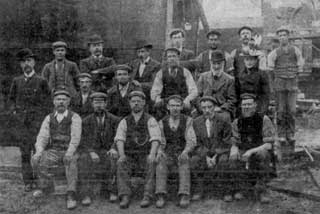The information presented is there to be used and enjoyed but please be sure to
acknowledge the source and author if you use any material.
Snippets of Yesteryear
Thorne Gas Light and Coke Co.

Builders of the Gas Works, Union Road, Thorne, (circa 1882)
Builders of the Gas Works, Union Road, Thorne, (circa 1882)
THORNE gas works were constructed in 1826 to an 'improved principle' of Mr John Malam at a cost of £1,500, raised in £5 shares. Most of the shares were held by the families of long-standing businesses, farmers and solicitors in the town and surrounding area.
The works were on Poor House Road, now Union Road.
The pressure of the gas was said to be 'very low' to say the least. If you had two jets lit in a big house it was little better than two candles.
After a short time an ‘investigatory experiment' was tried. The idea was to burn turf and peat dug from the nearby moors. However the pipes and jets needed so much cleaning that it ended in failure.
GAS HOLDER
Several years later, a large gas holder was built on Union Road and this improved the gas pressure dramatically, so much so that more and more households were turning to this form of lighting. Whites Directory of 1846 names a Mr Jas Walker as an operative of some kind at the gas works. In 1857 there were six retorts at the gas works with an average size of 7' 6" long, 15" wide and a diameter of 14½". In 1867 the works were extended and the supply improved again and in the 1890's the 'New Gas Works' were built by local builder Mr James Micklethwaite Smith.
Moving to 1910 officials of the Board of the Management were:
Chairman, M Marsdin; manager J W Wilson; secretary J Acaster. It would appear that the chairman changed annually as the following year, 1911, it was Mr G Dunston and in 1912 it was Dr Arbuckle.
GAS SHOWROOM
Gas bills headed 'Thorne Gas Light and Coke Co' were paid either at a bank or at a small gas showroom set up in the first house on the right hand side of Union Road. Also on the right hand side of the road, just before the 'gas office' behind a wire fenced and gated area stood a large gas holder which has now been demolished.
The penny slot meters installed in the houses with a gas supply were emptied by two workmen. They had a two-wheel handcart, painted red, which had a box fastened to it with a padlocked lid. They would go from house to house emptying the meters - imagine how much a barrow load of old pennies would weigh!
Coal arrived at the Gas works via canal barge to the back of the works and also before the use of motor lorries, the coal was hauled by horse and dray by Mr Pigott, from Thorne South Station.
NAME CHANGE
By the 1940's the name on the billheads had changed to the South Yorkshire and Derbyshire Gas Co. Two long serving retort stokers were local men, Mr T Lumbley and Mr Goodhand. A gas fitter for almost 50 years was Mr Tom Watkinson who was later joined at the gas works by his brother George. Apart from fitting pipes, meters etc. in the late afternoon the fitters would check the street lighting for broken mantles and any other faults. Around this time the meters were set at 13ft per 1d.

DEMOLISHED
In the late 1950's, the Gas Works were completely demolished. The Fire Station was built on the site in 1961.
There is now nothing left to remind us of the Gas Works of Poor House Road, where coke was 1/6d a bag, buckets of tar could be bought and your pet's life could be ended painlessly.
F Dallas
Acknowledgements to Whites Directory 1826, 46, 67
and the memories of some of Thorne's senior citizens.
Thanks to Glyn Ambrose for permission to use this information.
© Thorne Moorends Regeneration Partnership. All Rights Reserved.
